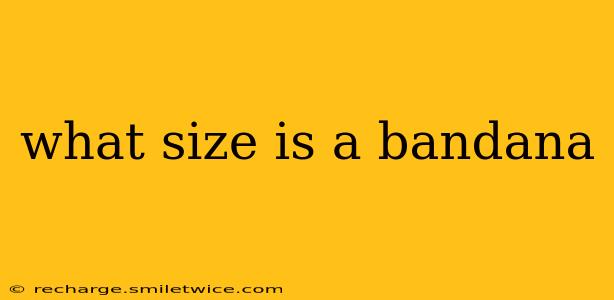What Size is a Bandana? A Comprehensive Guide to Bandana Dimensions
Bandanas, those versatile squares of fabric with a rich history, come in a variety of sizes. There's no single "standard" bandana size, as dimensions can vary depending on the manufacturer, intended use, and even the style. However, we can explore the common sizes and what factors influence their dimensions.
What are the most common bandana sizes?
The most common bandana size is 22 inches by 22 inches (approximately 56cm x 56cm). This size is versatile enough for most uses, from headwear to neckwear to even makeshift cleaning cloths. You'll find many bandanas available in this size, making it a good benchmark. However, you'll also encounter bandanas that are slightly larger or smaller.
Are there larger or smaller bandanas?
Yes, absolutely! You can find bandanas ranging from smaller sizes, ideal for children or for use as small accessories, to larger sizes that can be used as larger head coverings, scarves, or even part of a costume. Sizes like 18 inches by 18 inches are more compact, while sizes upwards of 27 inches by 27 inches offer more substantial fabric.
What factors affect bandana size?
Several factors influence the final size of a bandana:
- Manufacturer: Different brands may have slightly different sizing standards. Always check the product description for specific dimensions.
- Material: The material used to make the bandana can impact the final size slightly, due to differences in weave and fabric shrinkage after washing.
- Intended use: Bandanas designed for specific uses, like motorcycle riding or specific sports, may have different size recommendations to ensure optimal functionality.
- Style: Some bandanas may be pre-folded or have additional features that affect the overall dimensions when compared to a simple square bandana.
How do I know what size bandana I need?
The best way to determine the right bandana size for your needs is to consider its intended use:
- Headwear: For head coverings, a 22-inch square is usually sufficient for most adults. Smaller sizes are suitable for children. Larger sizes allow for more coverage or looser tying options.
- Neckwear: Smaller sizes can work well as a neck scarf, while larger ones provide more material for wrapping.
- Other uses: For cleaning or other tasks, consider the size of the area you need to cover.
What about bandanas sold as part of a set?
Some bandanas are sold in sets of multiple, offering different sizes or patterns. These sets often cater to varied uses and preferences, so always check the individual dimensions of each bandana included.
Where can I find information on bandana sizes before buying online?
Always check the product description and specifications carefully before purchasing a bandana online. Reputable online retailers will provide detailed dimensions, and sometimes even images showing the bandana laid flat to help visualize the size.
By understanding the factors that influence bandana size and considering your intended use, you can easily choose the perfect bandana for your needs. Remember to always check the manufacturer’s specifications for precise measurements.
